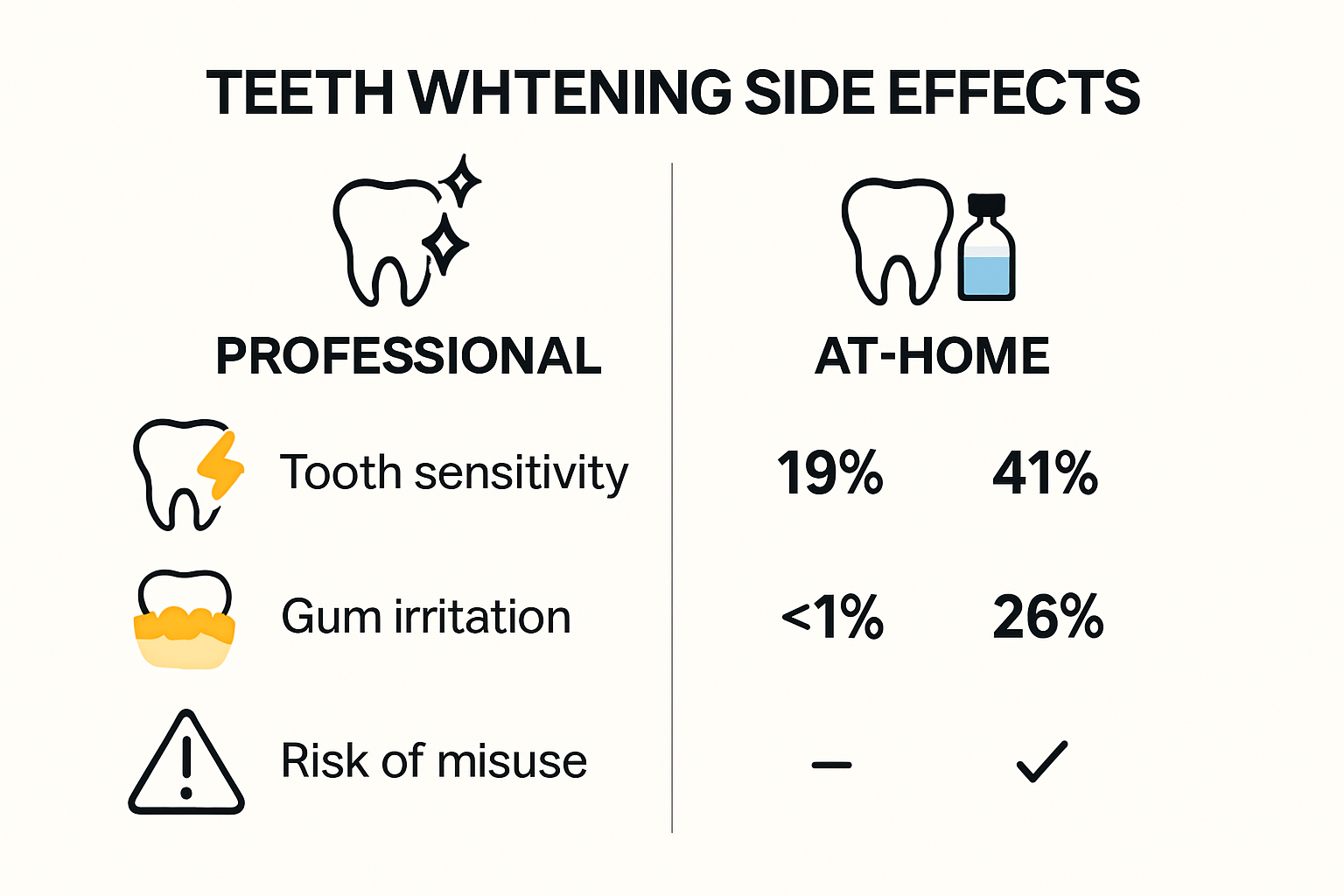
Teeth whitening is everywhere these days and promises a dazzling smile for everyone. But did you know that about 50.3 percent of people using at-home whitening experience noticeable tooth sensitivity after treatment? Most people think a brighter smile comes risk-free with any product from the store shelf. The reality is some methods work much better and safer than others especially when you factor in Edmonton’s unique climate and expert dental advice.
Table of Contents
- Understanding Teeth Whitening Methods
- Safety Concerns and Side Effects Explained
- Special Considerations for Edmonton Residents
- Choosing a Trustworthy and Accessible Dentist
Quick Summary
| Takeaway | Explanation |
|---|---|
| Professional whitening is most effective. | In-office treatments under dentist supervision yield the best results and control over the process. |
| Consult a dentist before whitening. | Dental professionals can assess your oral health and recommend the safest whitening options for you. |
| At-home products require caution. | Over-the-counter whitening options can cause sensitivity; following instructions is crucial for safety. |
| Consider local climate impacts. | Edmonton’s dry and cold weather may exacerbate tooth sensitivity, affecting treatment outcomes. |
| Choose a dentist with strong credentials. | Selecting a qualified dentist with comprehensive experience will enhance safety and effectiveness of whitening procedures. |
Understanding Teeth Whitening Methods
Teeth whitening represents a transformative cosmetic dental procedure designed to brighten and enhance the appearance of teeth. Modern whitening techniques range from professional in-office treatments to at-home solutions, each offering unique approaches to removing stubborn stains and discoloration.
Professional Whitening Techniques
Professional teeth whitening procedures provide the most controlled and effective method for achieving a brighter smile. Learn more about our professional whitening options at Unity Square Dental. According to a study published in the Journal of Evidence-Based Dental Practice, professional whitening is safe when manufacturer’s protocols are followed, though potential risks like tooth sensitivity exist.
Dentists typically employ two primary professional whitening methods. The first involves in-office bleaching, where concentrated hydrogen peroxide solutions are applied under strict professional supervision. As the NCBI Bookshelf research explains, hydrogen peroxide releases active oxygen molecules that break down chromophore molecules, effectively whitening teeth.
The second professional approach includes custom-fitted whitening trays created specifically for an individual’s dental structure. These trays ensure even application of whitening gel and minimize potential soft tissue irritation. This method allows for more gradual and controlled whitening compared to over-the-counter alternatives.
At-Home Whitening Strategies
At-home whitening options provide flexibility for patients seeking more convenient solutions. These typically include over-the-counter whitening strips, gels, and paint-on whiteners. While these products can produce noticeable results, they generally contain lower concentrations of whitening agents compared to professional treatments.
Consumers should exercise caution and follow product instructions carefully. Overuse or improper application can lead to increased tooth sensitivity or uneven whitening. Individuals with existing dental conditions like cavities, exposed roots, or significant tooth decay should consult a dental professional before starting any whitening regimen.
Important considerations for at-home whitening include understanding your current dental health, realistic expectation setting, and recognizing that results can vary based on individual factors such as age, original tooth color, and the type of staining present. Some stains respond more effectively to whitening treatments than others, with external stains from coffee, tea, or tobacco typically being easier to remove compared to intrinsic stains caused by medication or dental trauma.
Whether choosing professional or at-home methods, patients should prioritize consultation with dental professionals who can provide personalized recommendations based on individual dental health and aesthetic goals. Proper technique, consistent oral hygiene, and realistic expectations remain key to achieving successful teeth whitening results.
Safety Concerns and Side Effects Explained
Teeth whitening is a popular cosmetic dental procedure that requires careful consideration of potential safety concerns and side effects. Understanding these factors helps patients make informed decisions about their dental aesthetic treatments.

Common Physiological Responses
Explore our comprehensive dental safety guide to understand potential whitening reactions. According to Johns Hopkins Medicine, tooth sensitivity and gum irritation are the most frequently reported side effects of teeth whitening procedures. Research indicates that approximately 50.3% of at-home whitening users experience tooth sensitivity, with in-office treatments showing slightly lower rates around 39.3%.
The physiological responses typically result from the whitening agents temporarily opening dental tubules, which can cause transient discomfort. Patients might experience increased sensitivity to temperature variations, particularly with hot or cold beverages. This sensation usually subsides within 24 to 48 hours after treatment, but individuals with pre-existing dental sensitivities should discuss potential mitigation strategies with their dental professional.
Risk Factors and Professional Recommendations
The American Dental Association recommends a comprehensive clinical examination before initiating any whitening procedure. Certain risk factors can increase the likelihood of adverse reactions, including:
- Existing dental conditions: Untreated cavities, exposed roots, or significant enamel erosion
- Personal dental history: Previous sensitivity to dental treatments
- Age-related considerations: Older patients may have more porous enamel
- Chemical sensitivities: Individual variations in response to whitening agents
Professional dental consultation becomes crucial in identifying potential risks and determining the most appropriate whitening approach. Some patients might require specialized treatments or alternative aesthetic solutions that minimize potential side effects.
Long-Term Safety and Responsible Usage
While short-term side effects are generally mild, responsible usage remains paramount. Overuse of whitening products can lead to more significant dental complications. Dental professionals recommend following specific guidelines:
- Adhere strictly to recommended application frequencies
- Use products specifically designed for dental use
- Avoid consecutive whitening treatments without professional guidance
- Monitor and report any persistent or unusual side effects
Patients should understand that teeth whitening is not a one-size-fits-all procedure. Individual factors such as original tooth color, existing dental work, and overall oral health significantly influence treatment outcomes and potential side effects. By approaching teeth whitening with informed caution and professional guidance, patients can achieve desired aesthetic results while maintaining optimal dental health.
Special Considerations for Edmonton Residents
Edmonton residents considering teeth whitening have unique factors to evaluate beyond standard dental considerations. Local climate, lifestyle, and specific regional health characteristics play significant roles in determining the most appropriate whitening approach.
Climate and Environmental Impacts
Edmonton’s distinctive climate presents specific challenges for dental health and whitening procedures. The city’s extreme temperature variations and dry winter conditions can potentially impact tooth sensitivity and whitening effectiveness. Learn about specialized dental care approaches that account for these unique environmental factors.
Cold temperatures and low humidity can exacerbate tooth sensitivity, a common side effect of whitening treatments. Residents should be particularly mindful of potential discomfort during winter months when temperature transitions are more pronounced. Dental professionals recommend gradual whitening approaches and using desensitizing products to mitigate these climate-related challenges.
Age and Lifestyle Considerations
Research published in the Journal of Clinical Pediatric Dentistry highlights important considerations regarding tooth whitening, particularly for younger populations. According to their study, while bleaching procedures can be effective, they may reduce enamel microhardness, suggesting the need for careful professional guidance.
Edmonton’s diverse population includes students, professionals, and families with varying dietary and lifestyle habits that impact dental aesthetics. Factors such as coffee consumption, outdoor activities, and dietary preferences can influence tooth discoloration and whitening effectiveness. Local residents should consider personalized approaches that take into account individual lifestyle factors.
Professional Guidance and Regional Expertise
The Journal of Evidence-Based Dental Practice emphasizes the critical importance of professional supervision during whitening procedures. For Edmonton residents, this means seeking local dental professionals who understand regional health nuances and can provide tailored recommendations.
Specific regional considerations include:
- Altitude and atmospheric conditions: Edmonton’s elevation can affect dental treatment outcomes
- Water composition: Local water mineral content might impact tooth enamel and whitening effectiveness
- Dietary patterns: Regional cuisine and consumption habits unique to Edmonton
While teeth whitening offers aesthetic benefits, Edmonton residents should prioritize comprehensive dental consultations. Professional assessments can identify individual risks, recommend appropriate treatments, and ensure safe, effective whitening experiences that account for personal health profiles and regional specificities.
Ultimately, successful teeth whitening in Edmonton requires a personalized approach that balances aesthetic goals with individual health considerations. By working closely with local dental professionals who understand regional health dynamics, residents can achieve optimal results while maintaining long-term dental wellness.
Choosing a Trustworthy and Accessible Dentist
Selecting the right dental professional for teeth whitening involves careful consideration of multiple factors beyond basic clinical expertise. Edmonton residents need a comprehensive approach to finding a dentist who can provide safe, effective, and personalized whitening treatments.
Professional Credentials and Expertise
Discover how to select the right dental professional for your specific needs. According to Johns Hopkins Medicine, consulting with a dentist before any whitening procedure is crucial to ensure safety and effectiveness. When evaluating potential dental professionals, patients should consider several key credentials:
- Professional licensing and board certifications
- Advanced training in cosmetic dentistry
- Specialized experience with teeth whitening procedures
- Continuing education in dental aesthetic techniques
- Membership in professional dental associations
The American Dental Association emphasizes that professional supervision is essential to minimize potential risks such as tooth sensitivity and gum irritation. This underscores the importance of selecting a dentist with comprehensive knowledge and hands-on experience in teeth whitening treatments.
Accessibility and Patient-Centered Care
Beyond technical expertise, accessibility plays a critical role in choosing a dental professional. For Edmonton residents, this means considering factors that extend beyond traditional clinic hours and location. Key accessibility considerations include:
- Flexible scheduling: Evening and weekend appointment availability
- Technology integration: Digital consultation options
- Communication approaches: Clear explanation of procedures and potential risks
- Comprehensive assessment: Thorough examination of individual dental health before recommending whitening
The Dental Health Foundation highlights that professional teeth whitening offers more than just aesthetic improvements. A trustworthy dentist provides personalized treatments that consider individual oral health conditions, potential sensitivities, and long-term dental wellness.
Evaluating Patient Experience and Trust
Patient testimonials, online reviews, and personal recommendations offer valuable insights into a dental practice’s reputation. Potential patients should look for professionals who demonstrate:
- Transparent pricing structures
- Comprehensive treatment consultations
- Willingness to discuss potential risks and limitations
- Patient education and preventative care approach
- Modern dental technology and techniques
Trustworthiness extends beyond clinical skills. A truly patient-centered dental professional creates an environment of comfort, understanding, and personalized care. They should be willing to answer questions, explain procedures in detail, and provide multiple treatment options tailored to individual needs.
Ultimately, choosing a dentist for teeth whitening is a personal decision that requires careful research and consideration. Edmonton residents should prioritize professionals who combine technical expertise, modern technology, patient-centered approaches, and a genuine commitment to individual dental health and aesthetic goals.

Below is a comparison table summarizing the key differences between professional and at-home teeth whitening methods as described in the article:
| Feature | Professional Whitening | At-Home Whitening |
|---|---|---|
| Supervision | Performed by dentist | Self-applied |
| Strength of whitening agents | Higher concentration | Lower concentration |
| Effectiveness | Most effective, controlled | Variable, less predictable |
| Risk of Sensitivity | Lower (approx. 39.3%) | Higher (approx. 50.3%) |
| Customization | Custom-fitted trays & guidance | Standard application, less personalized |
| Convenience | Requires dental visit | Can be done at home |
| Cost | Higher | Lower |
The following table organizes common safety concerns, side effects, and risk factors highlighted in the article for easier reference:
| Factor | Description/Example | Professional Recommendation |
|---|---|---|
| Tooth Sensitivity | Discomfort with temperature, 39.3%-50.3% occurrence | Often subsides in 24-48 hours; mitigate with dentist advice |
| Gum Irritation | Reaction to whitening agents, typically mild | Use custom trays and seek supervision |
| Existing Dental Issues | Untreated cavities, exposed roots, enamel erosion | Comprehensive exam before whitening |
| Age-Related Risks | Porous enamel in older patients | Professional guidance needed |
| Overuse | Using whitening too frequently, leading to complications | Strictly follow recommended frequency |
| Chemical Sensitivities | Individual response to whitening agents | Dental consultation recommended |
| Inadequate Technique | Improper application (esp. at-home) | Follow instructions & seek dental advice |
Frequently Asked Questions
Is teeth whitening safe?
Teeth whitening is generally safe when conducted under professional supervision. However, at-home whitening products can lead to side effects like tooth sensitivity and gum irritation if not used properly.
How does professional teeth whitening differ from at-home treatments?
Professional teeth whitening involves stronger agents and custom care from a dentist, resulting in more effective and controlled outcomes compared to lower-concentration at-home treatments.
Why do some people experience tooth sensitivity after whitening?
Tooth sensitivity can occur due to the whitening agents temporarily opening dental tubules, which may lead to discomfort with temperature changes. Approximately 50.3% of at-home users report this side effect.
What should I do before starting a teeth whitening regimen?
Consult a dentist to assess your oral health and discuss the safest and most effective whitening options for your individual needs.
Experience Safe and Professional Teeth Whitening in Edmonton
Are you feeling anxious about tooth sensitivity or unpredictable results after at-home whitening? You are not alone. This guide highlighted how improper teeth whitening can increase your risk of discomfort, uneven results, or even gum irritation. Choosing the right, dentist-supervised method is essential to protect your smile and your long-term health. At Unity Square Dental, our team uses the latest dental technology and a personal approach every step of the way. See how our accessible, family-friendly dental clinic in Edmonton brings comfort and expertise together for every whitening visit.

Take the guesswork out of safe teeth whitening. Book a consultation now and let us tailor solutions for your needs. Learn more about how our dental professionals ensure a safer, more comfortable whitening experience or schedule your visit at Unity Square Dental today. Secure your brighter smile now before seasonal spots fill up.
Recommended
- Teeth Whitening Options for Families in Edmonton 2025 – Unity Square Dental
- Teeth Cleaning vs Whitening: Guide for Edmonton Families 2025 – Unity Square Dental
- How Often to Visit Dentist in Edmonton: 2025 Family Guide – Unity Square Dental
- What Is a Family Dentist? Guide for Edmonton Families 2025 – Unity Square Dental

